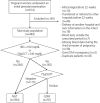Role of random blood glucose and HbA1c levels in optimizing glucose tolerance screening in early pregnancy: a retrospective cohort study
- PMID: 40576006
- PMCID: PMC12301561
- DOI: 10.5468/ogs.25052
Role of random blood glucose and HbA1c levels in optimizing glucose tolerance screening in early pregnancy: a retrospective cohort study
Abstract
Objective: Random blood glucose (rBG) levels are commonly measured in Japan; however, no standardized cutoff values exist for glucose tolerance screening in early pregnancy. The contribution of glycated hemoglobin (HbA1c) and glycated albumin (GA) measurements to the diagnosis of gestational diabetes mellitus (GDM) remains unclear. Therefore, we aimed to evaluate the significance of these glycemic indicators in early pregnancy for predicting GDM.
Methods: This observational cohort study enrolled pregnant women who underwent initial prenatal examinations to determine their rBG, HbA1c, and GA levels at a rural maternity facility. Clinical data were retrospectively reviewed.
Results: A total of 449 patients were analyzed, comprising 394 with normal glucose tolerance (NGT) and 55 with GDM. The rBG, HbA1c, and GA levels were significantly higher during early pregnancy in women who developed GDM than in those with NGT. Receiver operating characteristic curve analysis revealed that the areas under the curve (AUC) for rBG, HbA1c, and GA were 0.733, 0.591, and 0.608, respectively, with cutoff values of 100 mg/dL, 5.2%, and 14.6%, respectively. These cutoff values had sensitivities of 52.7%, 70.9%, and 36.4% and specificities of 87.6%, 43.4%, and 82.5%, respectively. The product of rBG and HbA1c levels demonstrated improved performance, with an AUC of 0.750, cutoff value of 509, 63.6% sensitivity, and 83.5% specificity.
Conclusion: Glucose tolerance screening in early pregnancy using an rBG level of 100 mg/dL and an HbA1c level of 5.2% as cutoff values may help identify high-risk cases and enable early diagnosis of GDM.
Keywords: Gestational diabetes mellitus; Glycated albumin; Glycated hemoglobin; Normal glucose tolerance; Random blood glucose.
Conflict of interest statement
The authors declare that they have no conflicts of interest.
Figures





Similar articles
-
Preexisting Diabetes and Pregnancy: An Endocrine Society and European Society of Endocrinology Joint Clinical Practice Guideline.Eur J Endocrinol. 2025 Jun 30;193(1):G1-G48. doi: 10.1093/ejendo/lvaf116. Eur J Endocrinol. 2025. PMID: 40652450
-
Fasting plasma glucose performs better than glycated hemoglobin and glycated albumin for diagnosing gestational diabetes.Int J Gynaecol Obstet. 2025 Jul 17. doi: 10.1002/ijgo.70370. Online ahead of print. Int J Gynaecol Obstet. 2025. PMID: 40673615
-
Use of oral glucose tolerance testing and HbA1c at 6-14 gestational weeks to predict gestational diabetes mellitus in high-risk women.Arch Gynecol Obstet. 2023 May;307(5):1451-1457. doi: 10.1007/s00404-022-06637-7. Epub 2022 Jun 7. Arch Gynecol Obstet. 2023. PMID: 35670847
-
Comparison of the ability to diagnose gestational diabetes mellitus between glycated albumin or fructosamine and hemoglobin A1c-a meta-analysis of diagnostic studies.Syst Rev. 2025 Jul 10;14(1):144. doi: 10.1186/s13643-025-02894-0. Syst Rev. 2025. PMID: 40640901 Free PMC article.
-
Different strategies for diagnosing gestational diabetes to improve maternal and infant health.Cochrane Database Syst Rev. 2017 Aug 23;8(8):CD007122. doi: 10.1002/14651858.CD007122.pub4. Cochrane Database Syst Rev. 2017. PMID: 28832911 Free PMC article.
References
-
- Diagnostic criteria and classification of hyperglycaemia first detected in pregnancy: a World Health Organization guideline. Diabetes Res Clin Pract. 2014;103:341–63. - PubMed
-
- Wang H, Li N, Chivese T, Werfalli M, Sun H, Yuen L, et al. IDF diabetes atlas: estimation of global and regional gestational diabetes mellitus prevalence for 2021 by International Association of Diabetes in Pregnancy study group’s criteria. Diabetes Res Clin Pract. 2022;183:109050. - PubMed
-
- Sweeting A, Hannah W, Backman H, Catalano P, Feghali M, Herman WH, et al. Epidemiology and management of gestational diabetes. Lancet. 2024;404:175–92. - PubMed
-
- ACOG practice bulletin no. 190: gestational diabetes mellitus. Obstet Gynecol. 2018;131:e49–64. - PubMed
-
- Hivert MF, Backman H, Benhalima K, Catalano P, Desoye G, Immanuel J, et al. Pathophysiology from preconception, during pregnancy, and beyond. Lancet. 2024;404:158–74. - PubMed
Grants and funding
LinkOut - more resources
Full Text Sources

